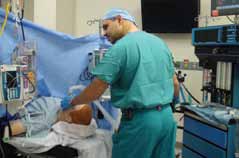BMC’s new simulation center provides state of-the-art medical training to strengthen coordination of care among specialties.
The mannequin, representing an 89-year-old woman, is lying on a stretcher in the preoperative area prior to surgical repair of a hip fracture. The anesthesia resident and preoperative nurse are conducting their final checks when the mannequin states, “I can’t breathe.” The nurse had started the patient’s antibiotic medication prior to entering the operating room. The patient’s heart rate increases from 60 to 150 and her blood pressure drops to 50. When the resident listens to her breath, he hears wheezing in her chest. The resident and nurse must now determine what has happened and the appropriate course of treatment.
Over the next 10 minutes, a simulation trainer will watch through a one-way window as the nurse and resident respond to the patient’s allergic drug reaction, which will include the administration of medications and intubation of the mannequin followed by cardiac arrest. For the participants, the scenario feels like a real emergency as they go through all the necessary resuscitation maneuvers.
Welcome to the world of medical simulation, where caregivers use computer-controlled equipment to develop and refine skills, and learn new procedures and treatment protocols before using them on actual patients. This spring, BMC completed construction on a 5,000-square-foot state-of-the-art simulation center in the home of the former Newton Pavilion Emergency Department. The new center consolidates various simulation areas around the hospital, including those located in Anaesthesia, Nursing, Pediatrics and the Menino Pavilion Emergency Department.
The new Solomont Clinical Simulation and Nursing Education Center will give staff the most realistic simulation experience possible using mannequins programmed with predefined scenarios. Entire teams will train while video cameras capture their actions for review in debriefing sessions following the simulations.
The experience is as real as it gets, explained Keith Lewis, RPh, MD, chair of BMC’s Anesthesiology Department.
“Simulation brings cases to life,” said Dr. Lewis, who has overseen the development of the center along with Lisa O’Connor, RN, BSN, MS, NEAA-BC, Senior Vice President for Clinical Operations and Chief Nursing Officer. “It’s not a technology, but a technique. It allows you to see the roles of various people, prevent errors and problems before they occur, and define how to get to a better outcome.”
Lisa O’Connor, RN, and Keith Lewis, MD, inspect one of the simulation rooms during the Center’s construction.
“Nursing, physicians and allied health professionals will routinely train on site as teams for high-risk scenarios as opposed to doctors and nurses training independently,” said Dr. Lewis. “We will be the only center in Boston to perform simulation this way.”
The center, which can accommodate up to 150 people, features three high fidelity simulation rooms, two task training rooms, two control centers, a classroom and conference room, and office and storage space. Building on the hospital’s reputation for pioneering minimally invasive robotic surgery, the center is also outfitted with simulation for the most advanced robotic surgical system in Boston.
The center’s vision was developed by BMC leaders with the common goal to create a simulation area that trains the caregivers of today and tomorrow to provide the safest care to BMC patients. That focus, of putting the patient first, is what the simulation center is all about, said O’Connor.
Donors Lend Crucial Support to New Center
Substantial funding for The Solomont Clinical Simulation and Nursing Education Center was raised at the 2011 BMC Gala, where donors gave $1.7 million for its construction. Other donors include longtime BMC partners Anaesthesia Associates of Massachusetts and the Massachusetts Memorial Hospitals Nursing Alumnae Association (MMHNAA). In addition, the BMC Medical and Dental Staff have given $400,000 toward this effort over the past four years. The Center is named in honor of former vice chair of the BMC Board of Trustees Alan Solomont and his wife Susan Solomont, who were honored at the 2011 BMC Gala. Space within the center will be named for Erwin Hirsch, MD, BMC’s longtime chief of trauma surgery, and in recognition of major support from the MMHNAA/Ross Fund Perpetual Trust, and for Dr. Ellison Pierce, a colleague of the Anaesthesia Associates of Massachusetts.
Courtesy of BMC’s Office of Development.






